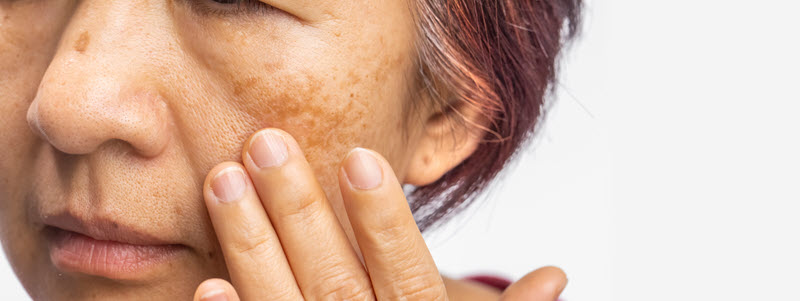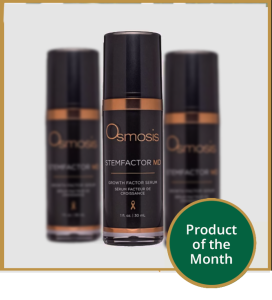Melasma is a common skin pigmentation disorder that manifests as freckle-like spots and gray-brown patches on the skin. It occurs due to the overproduction of melanin and is more pervasive in people with darker skin tones.
It is more noticeable in the summer and usually fades after a few months. In more stubborn cases, topical skincare products and cosmetic procedures come to the rescue.
This article presents common melasma symptoms, types, and triggers and offers practical advice for diagnosis and treatment.

What Is Melasma?
Melasma is a harmless hyperpigmentation resulting from excess melanin, a skin pigment responsible for your skin color.
The condition appears as flat, dark patches, a shade darker than your skin tone. Discoloration may subside after a few weeks, months, or even years. These spots usually darken during summer due to sun exposure.
Commonly affected areas are the forehead, nose bridge, cheeks, chin, and above the upper lip. Less common areas include the forearms, chest, and neck.
Melasma Types
There are three types of melasma based on the depth of the pigment. Each responds to treatment differently.
There are three basic melasma types:
- Epidermal melasma – Dark-brown patches with a well-defined border in the outer skin layer (epidermis) that are relatively easy to treat.
- Dermal melasma – Light-brown or bluish color with a blurry border, set in the deeper skin layer (dermis); it does not respond well to treatment.
- Mixed melasma – The most common type characterized by brown and bluish patches; it has a mild treatment response.
Most Affected Areas
Melasma typically affects the following regions:
- Centrofacial area – Forehead, cheeks, nose, upper lip.
- Malar region – Midface cheekbone area and nose.
- Lateral cheek pattern – Both cheeks have dark spots.
- Mandibular area – Jawline and chin.
- Extrafacial region – Forearms, upper arms, neck, chest, and shoulders.
What Causes Melasma?
The exact cause of melasma is unknown. Dark, discolored patches result from a variety of environmental, hormonal, and genetic factors that activate melanocytes, the specialized skin cells that produce the pigment melanin.
One of the leading causes of melasma is sun exposure, as the sun’s UV rays stimulate melanin production by activating melanocytes.
The hormones estrogen and progesterone are also implicated in melasma, which often develops during pregnancy (this is why it is also known as chloasma faciei or “the pregnancy mask”). Women taking oral contraceptives and hormone replacement therapy can also develop this type of skin discoloration.
A tendency to develop melasma also runs in families, indicating that genetics may play a role. Darker skin types have more active melanocytes and are, therefore, more prone to developing melasma.
Melasma Symptoms
The darker skin area is flat and smooth, with no changes in skin texture or thickness. Facial melasma is typically symmetrical, appearing on both sides (e.g., cheeks).
The discolored spots may become red or inflamed. However, melasma does not cause any pain, itchiness, or physical discomfort.
The most common melasma symptoms are the following:
- Hyperpigmentation
- Dark spots
- Discolored areas or macules
- Freckle-like spots
- Blotchy patches
- Grayish-brown or bluish patterns
Who Can Get Melasma?
This unpleasant skin condition can affect anyone at any time. However, some people are more at risk. People who are most melasma-prone include the following:
- Darker-skinned individuals – Darker skin types naturally produce more melanin responsible for skin pigmentation, which makes them more likely to develop melasma.
- Pregnant women - Studies show that estrogen and progesterone regulate pigment production, causing changes in skin color during pregnancy.
- Women between the ages of 20 and 40 – Hormonal shifts during women’s reproductive years increase the likelihood of skin discoloration due to frequent estrogen spikes.
- Menopausal women undergoing hormonal treatment – Hormone replacement therapy may worsen the condition due to excess estrogen.
- People with a family history of melasma – You are more likely to develop this disorder if you have blood relatives diagnosed with the condition.
How Is Melasma Diagnosed?
A skin expert performs a routine examination to determine the severity, type, and cause of the discoloration. These are the procedures that help dermatologists diagnose melasma:
- Physical examination – The doctor looks at the dark-colored skin patches for typical melasma signs, such as flat skin texture and symmetrical distribution.
- Blacklight or Wood’s light – This simple, non-invasive tool emits long-wave ultraviolet (UV) light to help identify abnormal pigmentation.
- Dermoscopy – The doctor uses an instrument called a dermatoscope to inspect skin lesions and changes that are invisible to the naked eye.
- Skin biopsy – This quick and safe procedure involves the removal of a small skin sample to help distinguish melasma from other skin conditions.
Melasma Treatment
The effectiveness of melasma treatments depends on various personal factors, such as skin quality, skin type, the severity of symptoms, and the overall health of the patient.
Topical Therapy
Topical medications include creams, lotions, and gels that typically contain tyrosinase inhibitors that prevent melanin formation and minimize hyperpigmentation.
The most common skin-brightening agents include the following:
- Aloe vera
- Azelaic acid
- Kojic acid
- Cysteamine
- Vitamin C
- Retinol
- Tretinoin
- Niacinamide
- Resveratrol
- Mandelic and glycolic acid
- Hydrocortisone
- Soybean extract
- Hydroquinone
Choose only skin products recommended for melasma, and always consult a skin expert to achieve optimal results.
Sunscreen
Daily use of sunscreen with a high SPF protects against harmful UV rays, preventing skin damage and diminishing premature aging signs. Prolonged sun exposure increases melanin production, leading to more prominent dark spots.
Choose mineral-based sunscreen products that contain zinc oxide and titanium dioxide to ensure optimal sun-blocking efficiency and antioxidant protection.
Note: Read the ultimate summer skincare guide and learn how to choose sunscreen.
Medication
Doctors may prescribe oral medication if topical treatments give unsatisfactory results. One of them is oral tranexamic acid (TXA), which has shown results when patients don’t respond to the topical hydroquinone treatment. The reported success rate of TXA is up to 89%.
Glutathione is a naturally occurring antioxidant with powerful skin-lightening properties and numerous other health benefits. It is typically administered topically or intravenously to treat melasma.
Note: Learn how to take glutathione effectively to prolong the results.
Chemical Peels
Chemical peels are a minimally invasive skin-resurfacing method that involves gently exfoliating the outer skin layer with a chemical solution. This cosmetic procedure can eliminate or improve skin discoloration and produce an even skin tone.
Peel treatments with ingredients such as TCA, kojic acid, retinoic acid, salicylic acid, and glutathione provide the best results for melasma. They are typically visible after four to six sessions.
Note: Compare chemical peel vs. laser treatments for more information.
RevitaPen Treatment
The RevitaPen treatment is a minimally invasive, no-needle alternative to microneedling. It reduces hyperpigmentation, enhances serum absorption, and restores the epidermal barrier.
A pen-like device creates nanochannels in the skin, enabling deeper penetration of Osmosis Facial Infusion, a product that stimulates elastin, collagen, and fibroblast production. The result is rejuvenated, firm, and elastic skin.
Note: Learn the difference between IPL and BBL laser treatments.
Dermaplaning
Dermaplaning involves physical skin exfoliation with a scalpel. This quick and safe procedure gives the best results in combination with a chemical peel session. Both these treatments enhance cell turnover and help achieve a brighter, more radiant appearance.
Note: Read our dermaplaning aftercare tips to prolong the results.
Microdermabrasion
Microdermabrasion is another cosmetic procedure that effectively fades dark spots and decreases hyperpigmentation. This gentle treatment strips away the outer skin layer with ultra-fine crystals, stimulating cell renewal and producing an even-toned complexion with lightning serums. A series of treatments repeated every seven to ten days yields optimal results.
Note: Discover how microdermabrasion and microneedling procedures differ.
Common Melasma Triggers
Many factors contribute to hyperpigmentation disorders, including sun damage, hormonal oscillations, and medication.
Possible melasma triggers include the following:
- Sun exposure or photodamage
- Infrared (heat) light
- Tanning beds
- Hormonal imbalance
- Pregnancy
- Birth control pill
- Thyroid dysfunction
- Chronic stress
- Cosmetic products
- Environmental irritants
- Phototoxic drugs
- Antiseizure medication
Note: Learn how to remove age spots and prevent further hyperpigmentation.
When to See a Doctor
Melasma is a benign skin condition that can disappear over time. If it becomes more persistent, a dermatologist will recommend a treatment plan based on the underlying cause and your skin type. Expert advice is essential to distinguish this pigmentation issue from other health conditions.
Conclusion
Melasma can be frustrating, especially if it continues to spread. While it is not a matter of medical concern, it can lower self-esteem and make you insecure about your looks.
The good news is that it is treatable with topical products, medication, and cosmetic procedures.
Learn how to keep melasma under control by contacting our skin experts at Vibrant Skin Bar.




